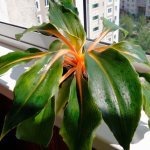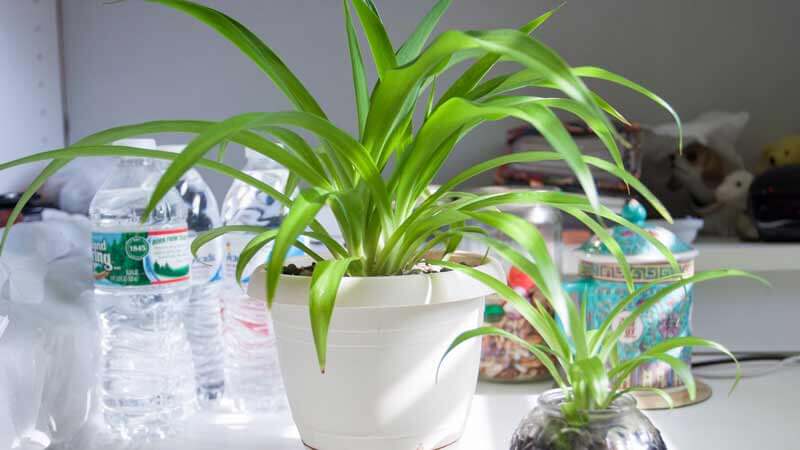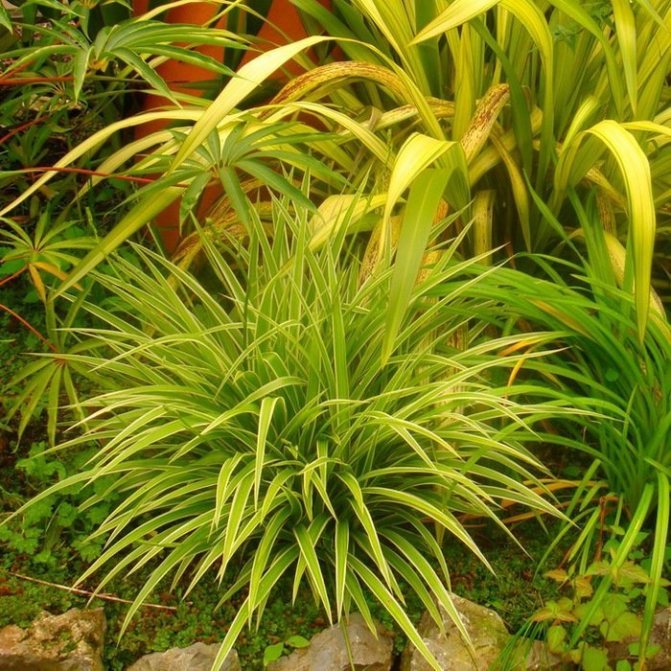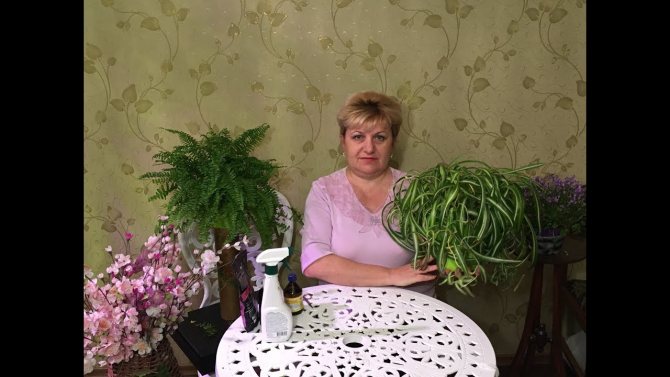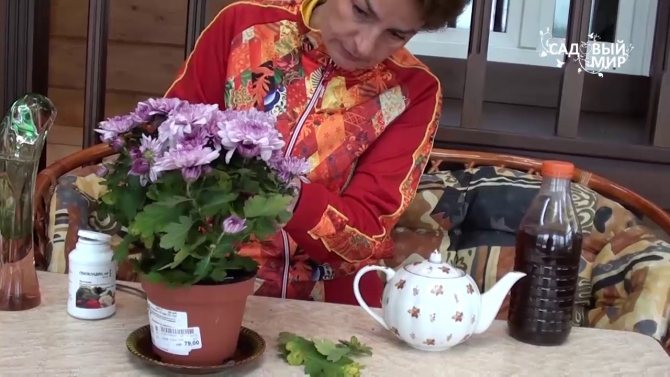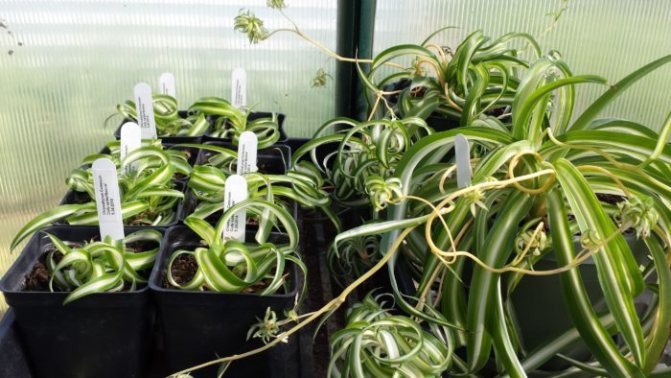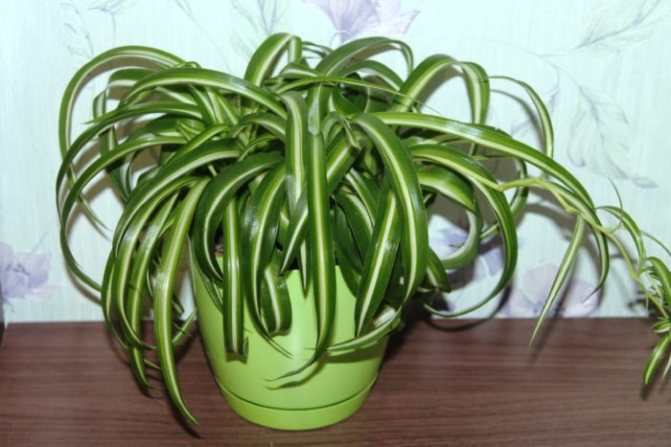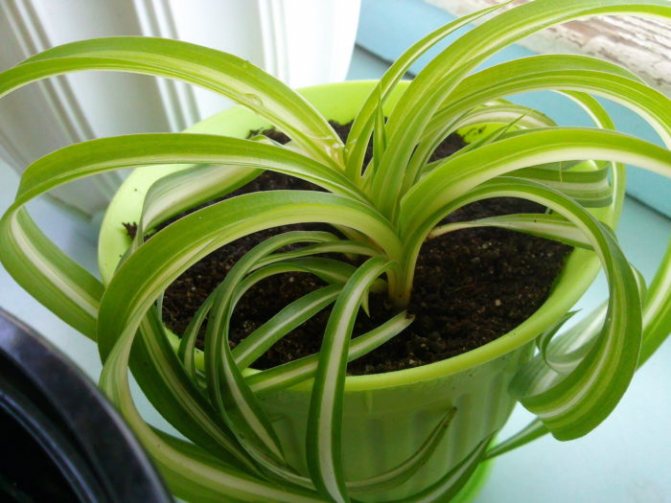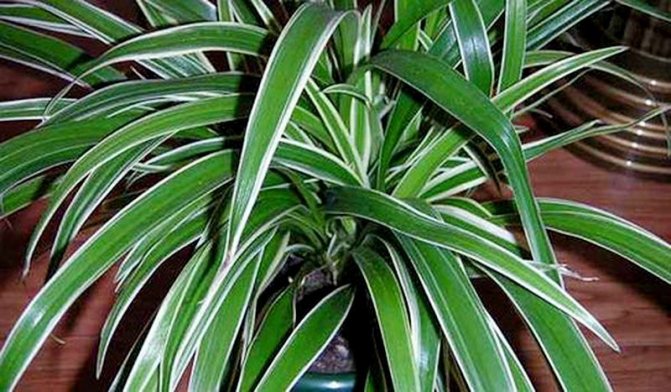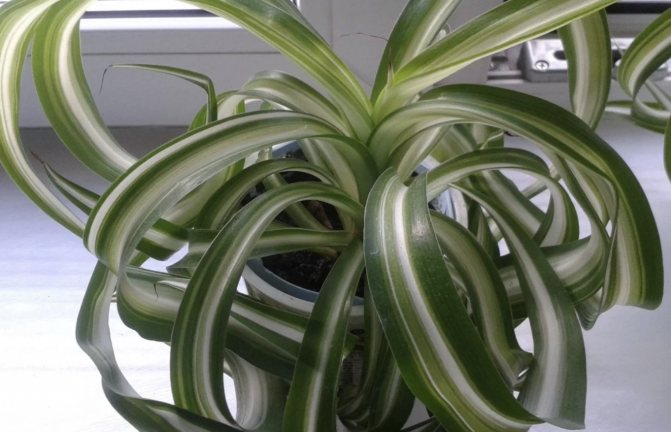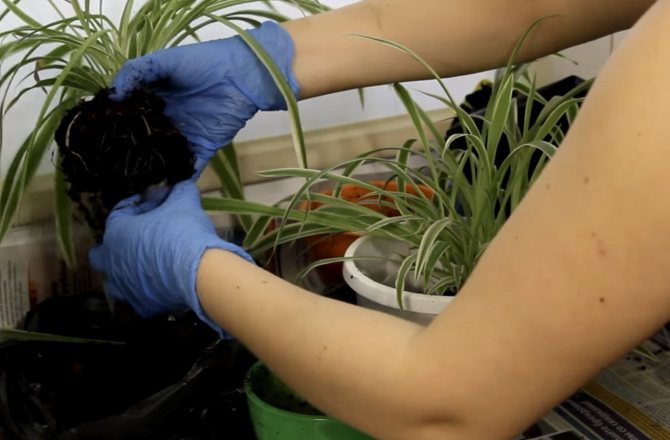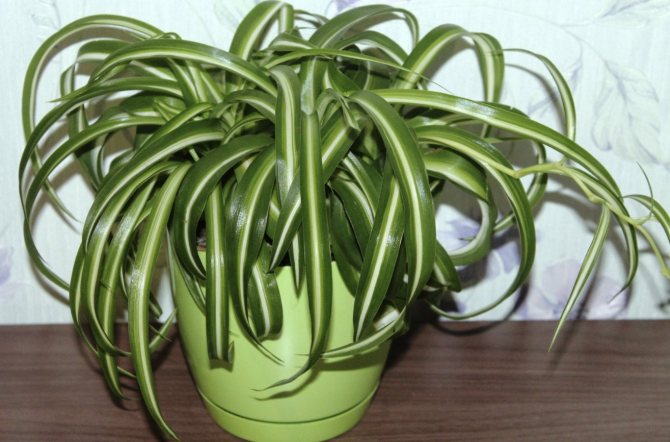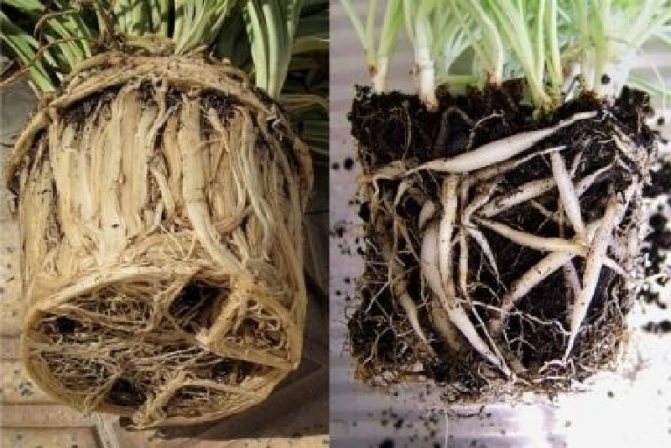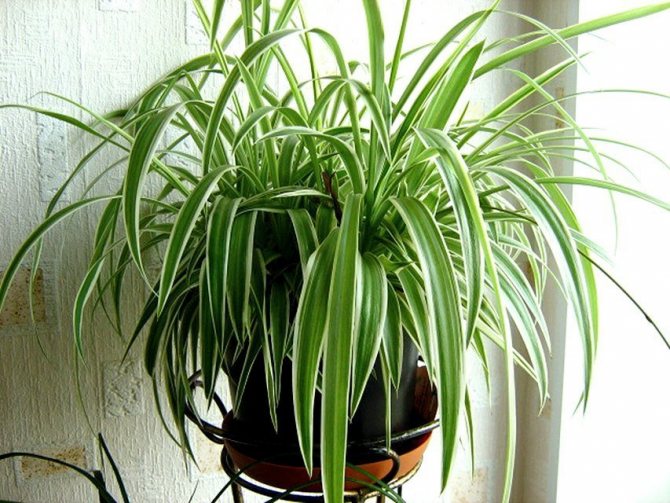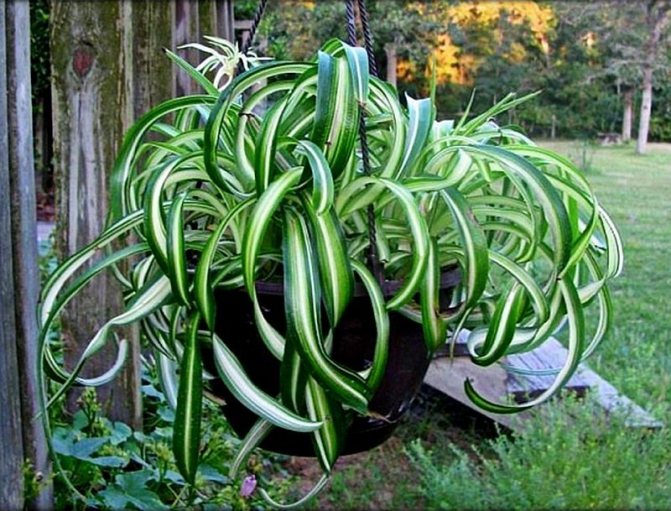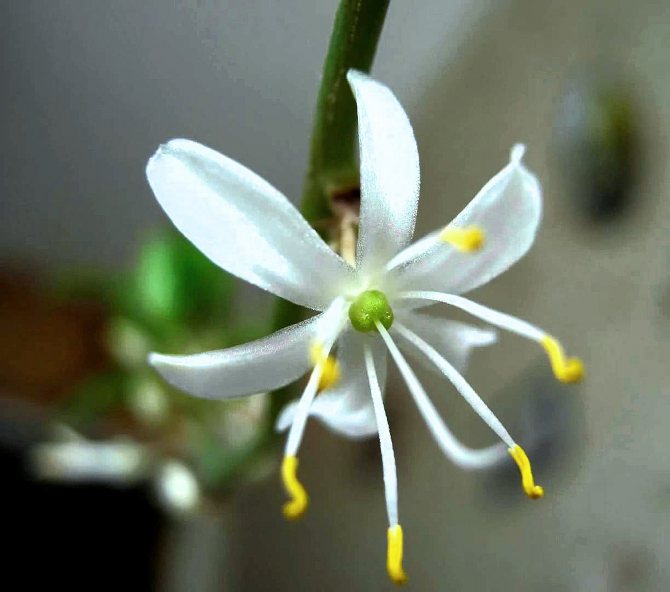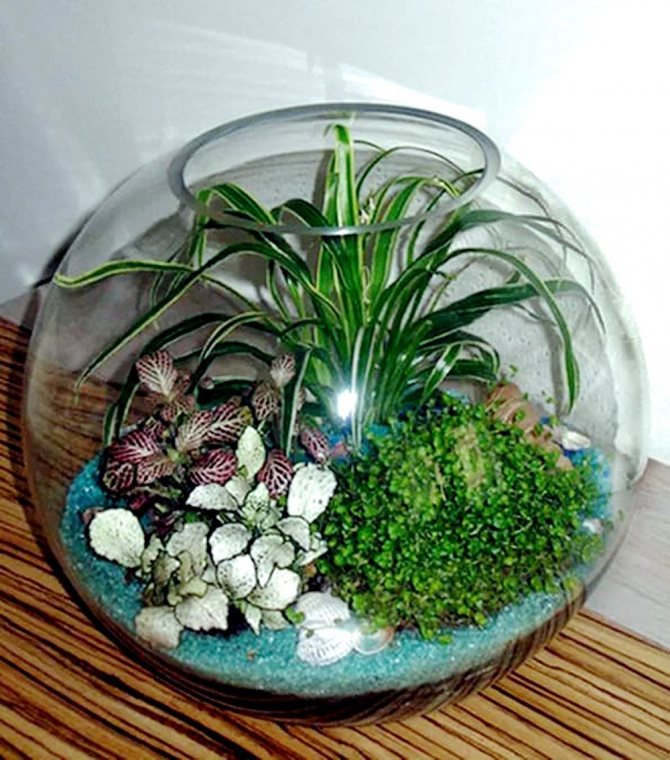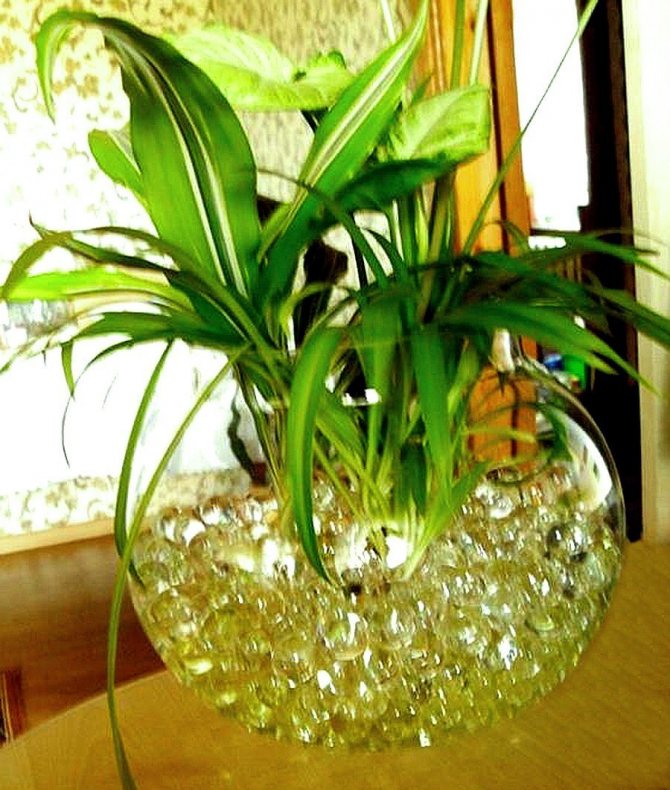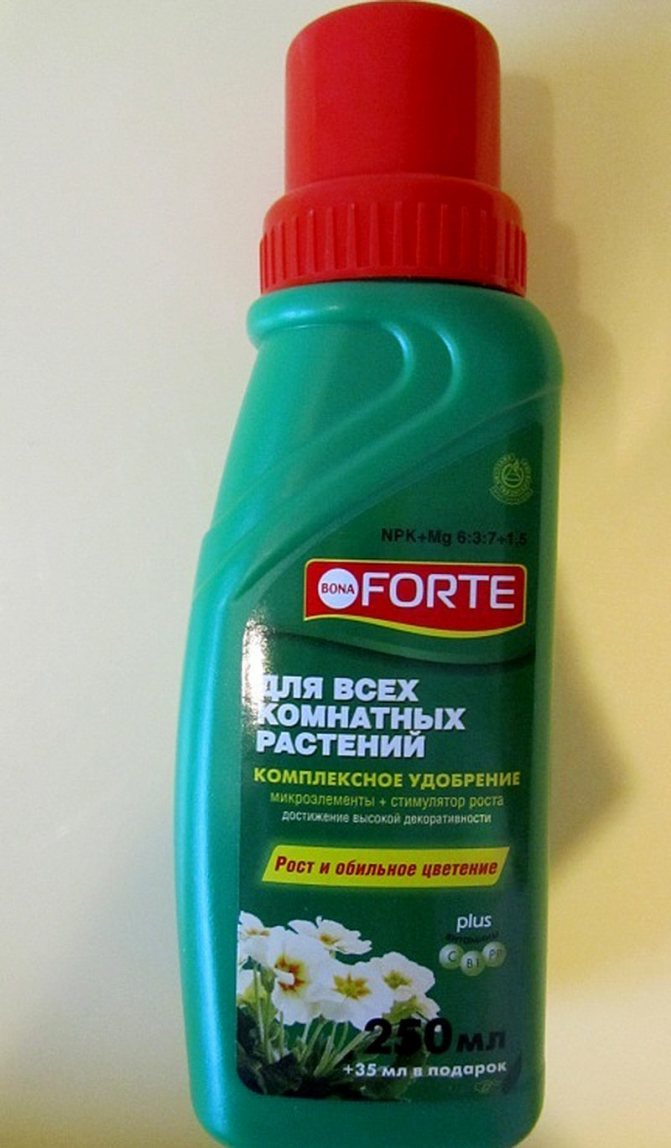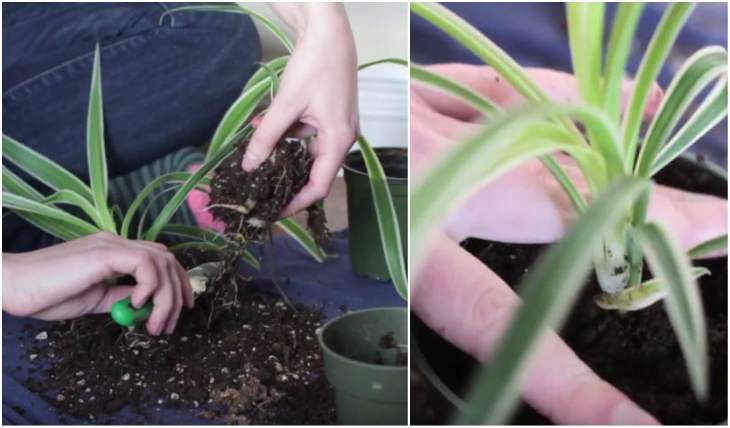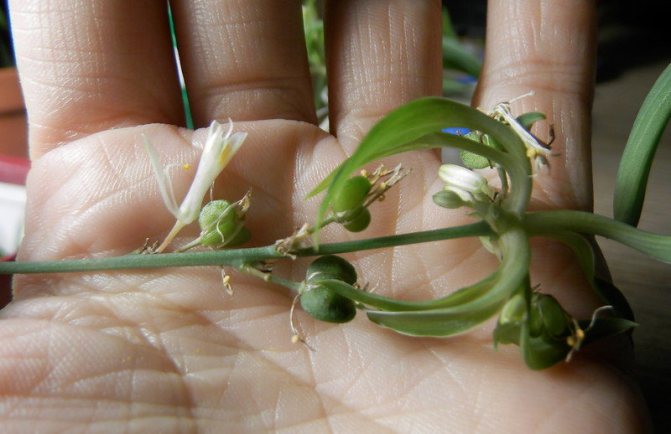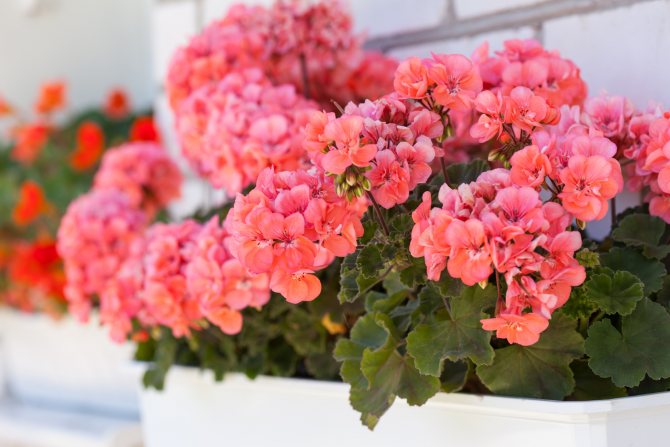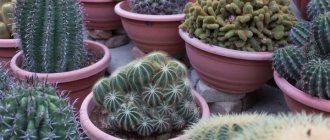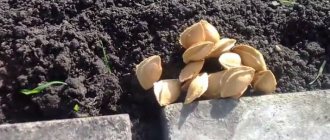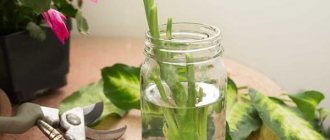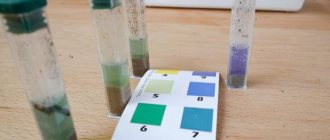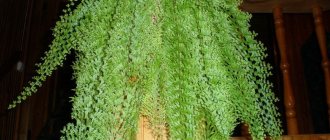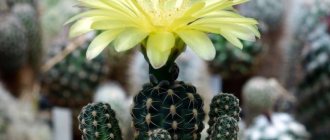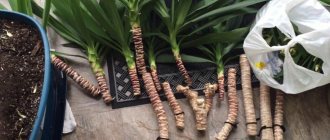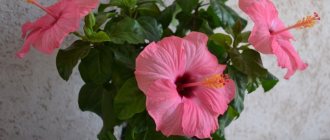Category: Houseplants
It is amazing how the chlorophytum plant, originating from tropical and subtropical geographic areas, has managed to adapt to the conditions of our homes and offices. Today it is difficult to imagine an accounting department or a waiting room without chlorophytum on the windowsill. Of interest is the fact that chlorophytum is one of the rare plants that can be used to decorate a bathroom, that is, a room in which there is usually little light. Chlorophytum can also be grown as an ampel. If there is a houseplant in nature for the lazy and irresponsible, then it is chlorophytum, but those who surround this unpretentious flower with care and attention will be pleasantly surprised.
The main types and varieties of chlorophytum: photos and names
To date, there are about two hundred and fifty plant species that grow in natural conditions. In home floriculture, the following varieties are most common:
Crested
Chlorophytum crested has a short stem with a bunch of curved, soft, narrow, light green lanceolate leaves up to sixty centimeters in length.
As you can see in the photo of the plant, white leaves and flowers resembling small stars are located on long hanging mustaches, after the flowering of which, new rosettes appear in the axils, which form a spectacular curtain around the main plant. In the future, they can be used for reproduction.
Kapsky
Chlorophytum Cape is somewhat larger than crested, its leaves are eighty centimeters long and three centimeters wide. They are light green in color, linear in shape and taper towards the apex. Small white flowers are arranged in loose racemes on long peduncles in the leaf axil.
A characteristic difference between Cape Chlorophytum from other species is that it has lateral processes are not formed... Therefore, it can only be propagated by dividing the bush.
Winged (orange, orange, orchidostellar)
Chlorophytum winged has wide oval-lanceolate wavy leaves of a dark green color with orange veins. They are tapering both to the bottom and to the top and have long cuttings ranging from pinkish to reddish-orange in color.
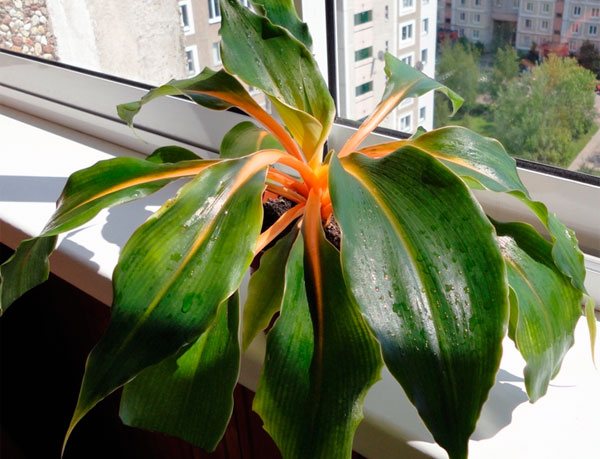
The photo of orange chlorophytum clearly shows that the plant has the shape of a bush, the height of which reaches thirty-five centimeters. Flowers are arranged on short peduncles in a spiral.
Curly (Bonnie)
The leaves of curly chlorophytum have a distinct white stripe along the central vein. It does not change color, even if the plant is kept in unfavorable conditions.
The plant owes its name to its beautifully curled leaves. The plant is quite compact, unlike other species, the Bonnie chlorophytum whiskers grow no more than fifty centimeters.
Laxum
Chlorophytum laxum is quite beautiful, but not very common. It has thin, narrow, drooping foliage, decorated with stripes of white along the edges. The socket is dense enough, there are no outgrowths. Small flowers are white in color.
Homemade chlorophytum - description
We have just talked about the main advantage of chlorophytum - ease of cultivation and care.There are some more features that distinguish it from other plants:
- chlorophytum blooms in March and blooms throughout the growing season;
- the dormant period for the plant is from October to January;
- indoor chlorophytum grows well in hydroponics;
- sometimes, as a result of insufficient watering or too dry air, the tips of the leaves of chlorophytum dry out, and the plant to some extent loses its decorative effect;
- chlorophytum is good not only in a hanging basket or on a stand, it can even decorate a flower bed in a garden with its variegated leaves;
- Chlorophytum looks great both as a solo plant and in a group with other plants.
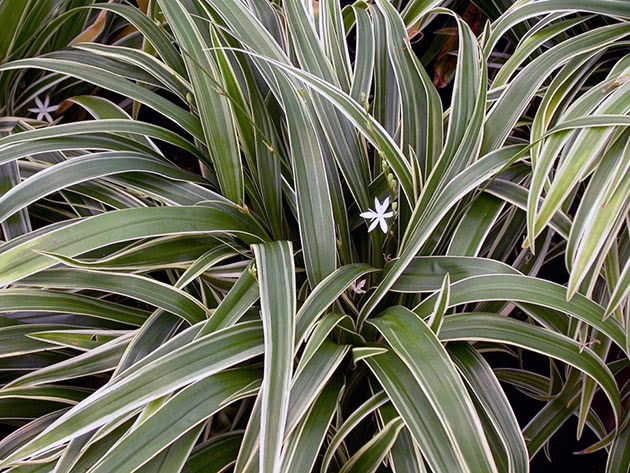

How to care for chlorophytum
If you do not have time for careful plant care or you are not at home for a long time, but there is a desire to decorate your house with plants, then start chlorophytum. It completely undemanding to care and is able to endure a lack of attention to oneself and recover quickly.
Lighting
For chlorophytum, the level of illumination does not play a big role, it grows well both in bright light and in the shade. But, naturally, in a bright place in the room, its foliage will be more abundant and wider, and the rosettes will be larger and more numerous. In summer, the plant can be taken out onto the balcony.
In a very shaded room, variegated species may lose their decorative effect.
Temperature and humidity
In the summer, the indoor plant chlorophytum is recommended to be kept at a temperature of twenty to twenty-five degrees. In winter, you can lower it to eighteen degrees. The plant will not die from drafts, but it may acquire an unsightly appearance.
Although humidity is not particularly important to chlorophytum, it nevertheless responds well to regular spraying and a warm shower to rid its leaves of contamination.
Watering and feeding
Chlorophytum belongs to moisture-loving plants, therefore, in the spring and summer, it requires abundant watering. They have been cut since autumn. In this case, both transfusion and overdrying of the soil should be avoided.
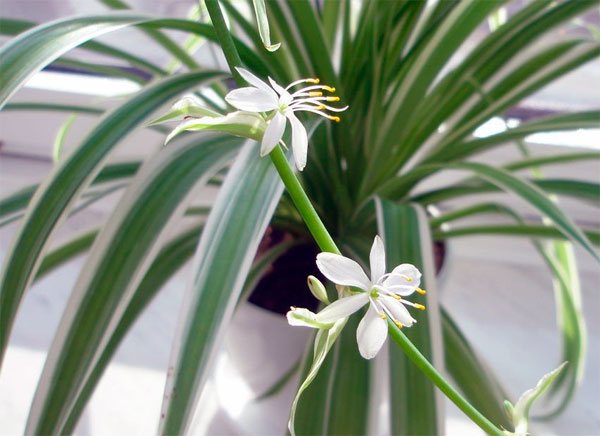

Plant feeding is carried out from early spring to late summer every week. For this, they use complex mineral fertilizers, which contribute to the active growth of chlorophytum.
The soil
For planting chlorophytum, they use loose, breathable, nutritious soil. Her can be composed of the following components:
- Sod land - 2 parts, leafy land - 2 parts, sod land - 2 parts, coarse sand - 1 part;
- Sod land - 3 parts, leafy land - 2 parts, coarse sand - 1 part.
Chlorophytum can be propagated by lateral processes (rosettes), dividing bushes and seeds.
Home care
Due to the unassuming nature of chlorophytum, caring for a representative of the tropical flora is within the power of even a novice florist who has not yet grasped many of the intricacies of cultivating potted crops.
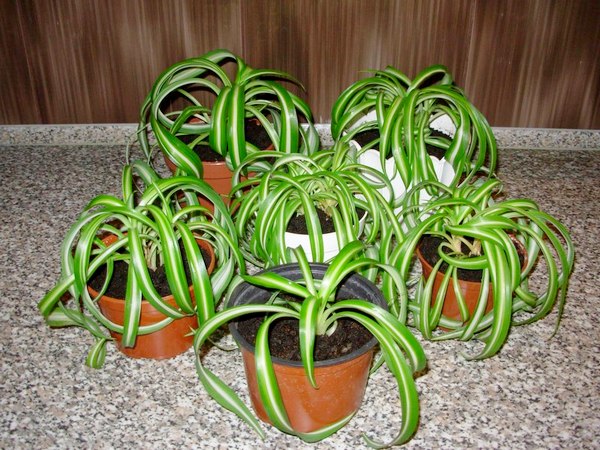

Lighting and location
To maintain decorative qualities, a shade-tolerant plant should be placed on the windowsills of eastern or western windows, where curly chlorophytum will receive a sufficient amount of bright, direct sun in the morning or evening, when the activity of the rays is minimal.
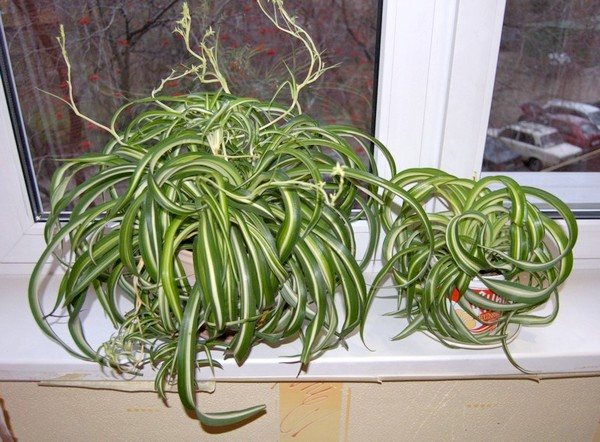

Pruning and shaping the crown
The crown of the flower has natural beauty, for which it is highly valued by flower growers. But despite the fact that chlorophytum with two or three tiers of peduncles, crowned with new rosettes, looks very impressive, arrows should be trimmed, unless reproduction is planned.
To maintain decorativeness and stimulate the formation of new leaves, it is recommended to remove diseased and damaged shoots in a timely manner.
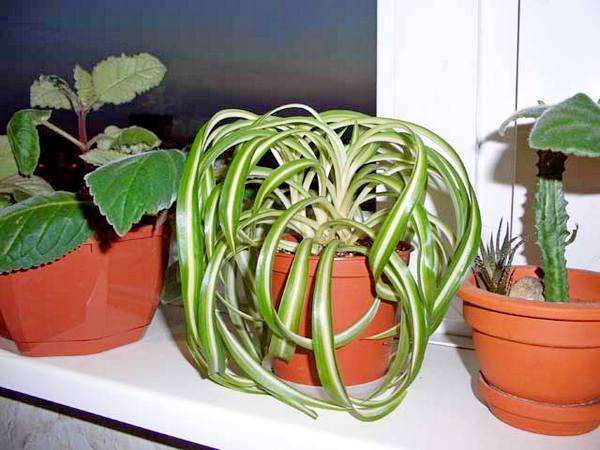

Watering chlorophytum
The optimal watering system for a flower depends on the phase of development, which falls on different time periods:
- During the active growing season (spring-summer), chlorophytum is watered frequently and abundantly, removing the remaining water from the sump.
- During the preparation and the onset of the dormant phase (autumn-winter), the flower needs such a moisture regime, in which the earthen lump does not dry out completely.
Important! Despite the tropical nature of the plant, chlorophytum is well tolerated for prolonged drought and can withstand up to 3-4 weeks without watering, which is very important for frequent travelers.
Air humidity
Curly chlorophytum feels great in the dry air of an apartment for three seasons, with the exception of the summer, when the plant needs daily spraying with settled water at room temperature.
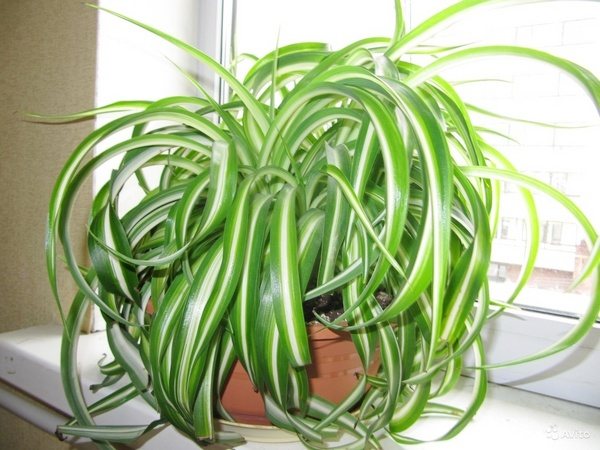

Top dressing and fertilizers
During the active growing season, when the plant intensively builds up its green mass, it is necessary to organize additional nutrition of chlorophytum twice a month with the help of liquid mineral fertilizers with a high nitrogen content.
Planting and transplanting a plant
So that the plant has strong immunity and pleases with its appearance, planting chlorophytum should be carried out in a nutrient substrate with a loose structure... With similar indicators, a soil mixture can be purchased in a store or prepared independently by mixing turf, humus, leafy soil and sand in a ratio of 2: 1: 1: 1.
See how to transplant it correctly:
At the bottom of the tank, a drainage layer of gravel or expanded clay is necessarily placed, which will help protect the roots from the development of rot due to stagnant moisture.
Due to the rapid growth rates that are observed with a competent approach to cultivation, curly chlorophytum needs an annual transplant, carried out in late winter and early spring according to the following scheme:
- A pot is selected, the diameter of which is 1-2 cm larger than the same parameter of the previous container.
- The bottom is lined with gravel to improve carrying capacity.
- Chlorophytum is being dumped from an old container.
- The free space is filled with a nutrient substrate, which is slightly compacted and moistened.
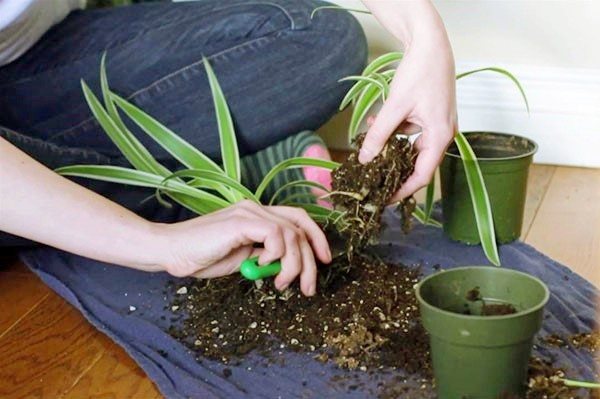

Temperature
For undemanding chlorophytum, room temperature is quite suitable. However, in winter, it is better to move the flower to a cooler room with temperature values in the range of 18-20 ° C.
Attention! The critical temperature minimum is 10 ° C.
Reproduction by rosettes
For this method, you need to prepare a new pot with the appropriate soil and place it next to the chlorophytum. Then you need to choose a well-developed rosette with leaves of at least seven centimeters in length. It must be dug into a prepared container and its stem must be reinforced in the soil with wire.
When rooting is over and the new plant grows, the stem is cut off.
You can also cut off the lateral process and place it in a container with purified water, in which you can dissolve a small amount of activated carbon. After the roots have reached a length of about three centimeters, the plant can be transplanted into soil. Further care for new plants is carried out in the usual way.
We have compiled a list of recommendations to help you take proper care of your azalea.
And here you can find out how to grow an azalea yourself or transplant it.
Description of alocasia flower and its photos are collected here:
Curly chlorophytum is the leader in decorativeness and unpretentiousness among indoor plants
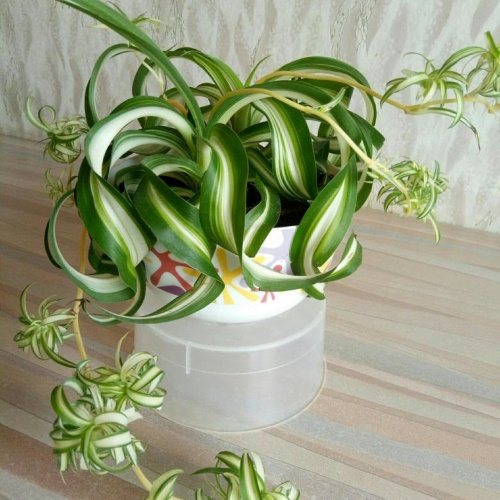

Like its relatives, this type of flower grows, forming a lush rosette from long and narrow leaves. However, curly chlorophytum cannot be confused with others: its leaves curl downward. One gets the impression that they are hugging the pot. In an adult specimen, a flowerpot is almost invisible under the dense, arched foliage.In addition, the leaf plate has a contrasting two-color color - alternating green and white longitudinal stripes.
In spring, long hanging arrows appear from the outlet. Small rosettes form at their tips, and small white flowers bloom among them. However, if the plant likes the conditions of detention, it can bloom in winter.
For the shape of the leaves, this chlorophytum is also called curly. It is also known as Bonnie Chlorophytum.
Reproduction by dividing the bush
It is not difficult to reproduce chlorophytum by dividing the bush. This is usually done in the spring during transplanting.
To do this, you need to remove the plant from the old pot and divide the rhizome into parts with a sharp disinfected knife, it is recommended to cut the roots that are too long. Then each part is planted in an individual container.
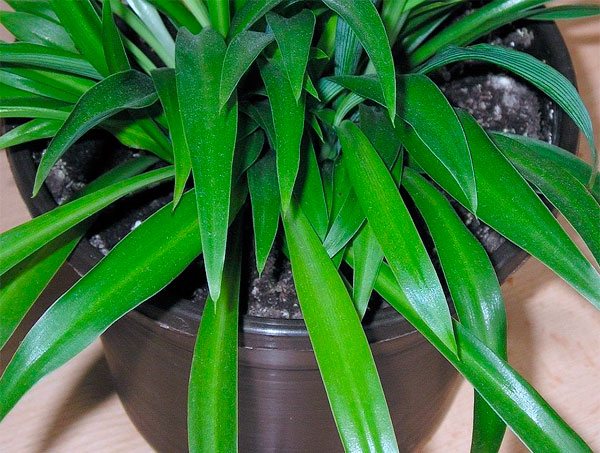

Why doesn't chlorophytum curl?
With age, the leaves of the flower become more wavy than curly. He may lose his former splendor and originality of form. This is often due to the fact that during the phase of active growth, chlorophytum threw out too many children and they take up a lot of its strength. However, babies will curl up without problems.
It is also possible that the flower does not curl due to the fact that there is no room in the pot for the development of the root system, and this closes the path to the full development of Bonnie. If such a problem has been noticed, then you should transplant it into a larger pot, and also regularly tear off some of the foliage and children so that there is enough moisture in the trunks for all life processes and the flower again takes on the desired shape.
Important!
Young plants of this species are more prone to leaf curling than adult crops.
Seed method of reproduction of chlorophytum
Since this houseplant reproduces quite easily by lateral shoots and dividing the bush, the seed method of reproduction is not relevant for him... But if there is a desire to try, then it can be done as follows.
From the fruits of chlorophytum ripe in spring, you need to extract the seeds and soak them for twelve hours in water or a solution of a growth stimulant. Then they need to be evenly distributed over the soil of peat with sand.
Crops are covered with glass or polyethylene film and placed in a room with an air temperature of about twenty-two degrees. The seeds germinate within a month and a half.
All this time, you need to remove the shelter for airing and spraying the plantings. After the shoots appear, they are completely removed. After the formation of the third leaf, the seedlings are planted in separate small containers.
When and how it blooms
Chlorophytum - species Green Orange, winged, green, Laxum
The plant blooms in the warm season. The flowers are of no decorative value. The foliage looks more attractive than the inflorescences.
Types of flowers
On short peduncles, small white flowers are formed, which in their appearance are completely nondescript.
Flowering period
Chlorophytum blooms in the spring and summer. Blooming inflorescences can be observed throughout the warm season.
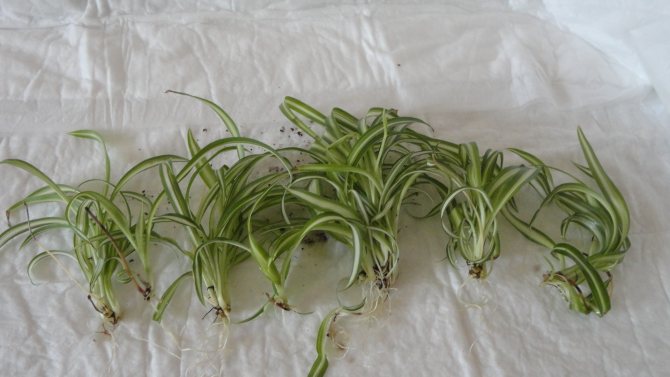

Delenki plants for planting
Changes in care during flowering
During the flowering period, the plant expends a lot of energy and nutrients. To replenish trace elements, they carry out regular feeding and watering. At this time, the bush begins to dry out especially quickly.
The most common chlorophytum diseases
Chlorophytum is not very susceptible to disease and pests. With improper care, it can become infected with scale insects and aphids. In this case, you need to wash the plant with soapy water and treat it with an insecticide.
Possible difficulties in growing chlorophytum:
- What to do if the tips of the leaves dry and turn yellow? This may indicate too low air humidity, you need to increase the number of sprays;
- Do not worry too much if the leaves of chlorophytum turn yellow and dry. For this flower, as for many herbaceous plants, leaf dieback is a natural process. If chlorophytum turns yellow and dries more than usual, then the room is too dry or too weak lighting. It is necessary to increase watering and spraying and move the plant to a brighter room. Dry leaves should be trimmed regularly;
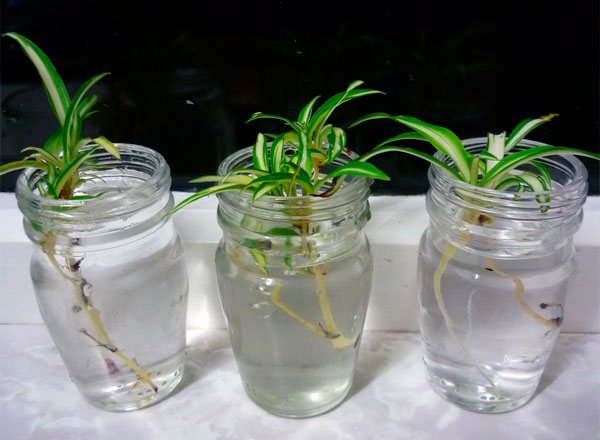

- If the tips of the leaves turn black in chlorophytum, this may indicate a lack of nutrients or the room temperature is too high and the air humidity is too low. It is necessary to revise the conditions for keeping the plant;
- If chlorophyllum is not growing, then most likely the plant is planted in too large a container. It will not actively grow until the roots encircle the entire earthy clod. You can transplant chlorophytum into a smaller pot or increase the feeding with fertilizer with a high nitrogen content, which contributes to the active growth of green mass;
- There is no flowering. Chlorophytum stops blooming in a very cramped pot. In this case, the plant should be transplanted into a large container.
Diseases and pests
Chlorophytum is practically not affected by pests. In summer, aphids can attack it outdoors. In this case, it is enough to treat the leaves with any insecticide. Rare varieties grown in industrial greenhouses can be infested with scale insects. You can get rid of the parasite with the help of drugs such as Fufanon, Bi-58.
Chlorophytum may be affected by fungal diseases: root or gray rot. In the first case, with wet soil, the leaves begin to turn yellow and wither. Black spots may appear at their base. The plant is removed from the pot, the roots are completely freed from the soil, all rotten parts are removed, sprinkling the cuts with crushed charcoal. After they are planted in a tight container, watered carefully. If there are no healthy areas of the root system left, the plant cannot be saved. The second disease is manifested by a gray fungal bloom covering the leaves. Appears as a result of an aphid attack. The affected leaves are removed, the bush is treated with copper chloride or Fundazol.
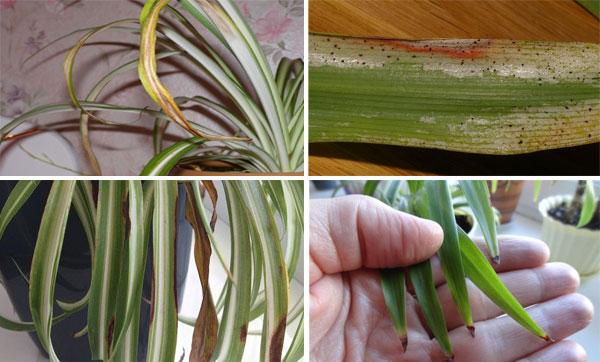

What are the benefits of chlorophytum for the home?
Folk omens say that chlorophytum brings family happiness to the house. In addition, it has been scientifically established that hazardous impurities and carbon monoxide disappear in the room where it is located. Therefore his recommended for use in kitchens with gas stoves.
Another useful property is that by emitting a large amount of oxygen, chlorophytum feeds on nitrogen oxides, formaldehydes and other substances harmful to humans.
In addition, this flower humidifies the air in the room, helps to eliminate harmful microorganisms, especially in the vicinity of geraniums, and absorbs dust.
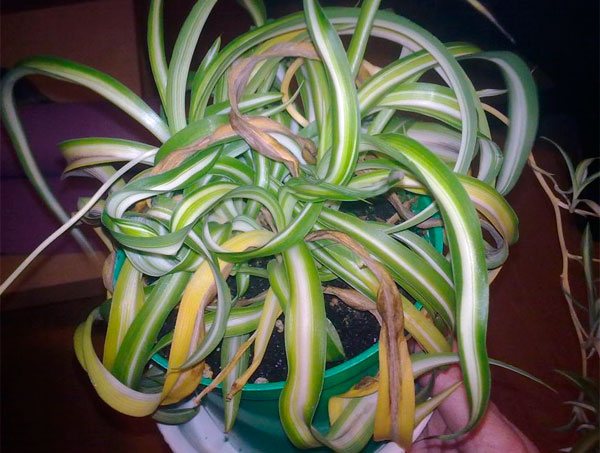

According to the theory of feng shui, chlorophytum eliminates the effects of negative energy in the house. It is recommended to give it to workaholics, so that they finally pay attention to other aspects of life.
The plant brings harmony, contributes to the creation of coziness and comfort in the room. It is noticed that scandals stop in the house where chlorophytum grows. In addition, it is used as a cat herb. Cats eat it with pleasure to remove hairballs from their stomachs.
Chlorophytum properties
The chlorophytum plant in your apartment is not only an interior decoration, but also a real filter for air purification - that is why most often housewives keep it in the kitchen, where various harmful impurities from the heat treatment of food, smoking and hygiene chemicals are in the air. And one adult chlorophytum is able to neutralize these miasms by 70-80%.On an area of two meters, one chlorophytum is able to destroy all pathogenic microflora, while humidifying the air for your comfort, if, of course, you do not forget to water it.
To enhance moisture exchange, put a couple of activated charcoal tablets in a pot with a plant, directly on the ground. In addition, sometimes you can shower chlorophytum to remove dirt and dust from its leaves, and then it will again be ready to cope with its duties of cleaning and humidifying the air in your home. There is such a nice prejudice: if you bring chlorophytum to a new house or apartment, then very soon your home will become cozy and calm, because where chlorophytum is, there is no place for irritation and bad memories.
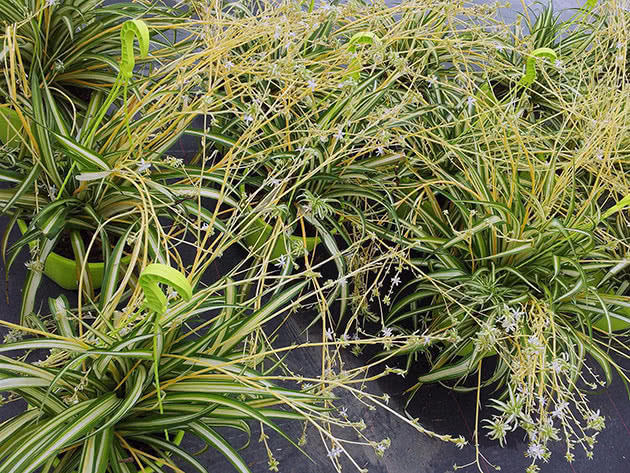

And experts in feng shui claim that chlorophytum is able to cleanse the aura and bring harmony into the life of a busy person, to even out imbalances in the owner's personal life. Should I believe? I do not know. But from the fact that the air in your room will become cleaner, you definitely won't get any worse, right?
Read Before You Buy Chlorophytum
When buying chlorophytum, you need to choose well-developed plants without signs of mechanical damage and any diseases. You also need to inspect them for pests. Depending on the variety and condition of the plants, the price for them ranges from three hundred rubles to one and a half thousand.
This article contains all the necessary information about adenium flowers.
From here you will learn how to buy good adenium seeds and plant them correctly.
What are indoor anthurium flowers, and how to care for them.
Chlorophytum is one of the most unpretentious plants. Therefore, it is well suited for growing to novice growers and people who are too busy. Even if the rules for its maintenance are somewhat violated, this, as a rule, does not greatly harm the plant, the main thing is to eliminate the problems that have arisen in time.
Brief description of the flower
The chlorophytum flower came to us from South America, where it settles along water bodies. It is a herbaceous perennial belonging to the asphodelic family. Despite its proximity to liliaceae, it does not form bulbs. The stem is short. The leaves are narrow and long, lanceolate, with an arcuate bend, can reach 40 cm. Their color varies depending on the variety and variety, can be monochromatic or variegated. The roots of the plant are strong, with thickenings in which moisture accumulates.
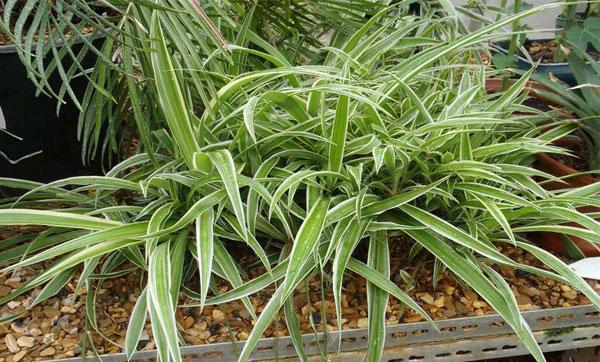

Flowers are small, white; are formed all year round on numerous long shoots growing from the center of the rosette. After flowering, daughter rosettes with aerial roots are formed in their place. The fluffy bush is complemented by a cascade of its miniature copies - children. It is thanks to this feature that chlorophytum has received the nickname "merry little family" among the people.
Growing conditions
Chlorophytum adapts perfectly to any environment. But it is still not advisable to create extreme conditions for it, so that the flower can help you, and not spend all its energy on maintaining its existence.
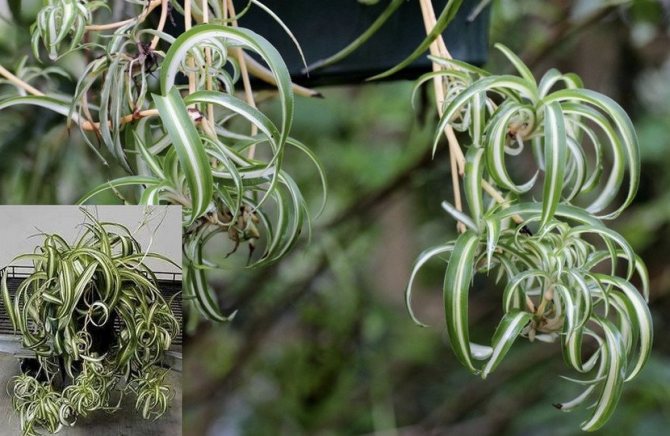

Placement and lighting
A flower for growth and development will only need 3-4 hours of daylight. This is the minimum illumination at which chlorophytum can live peacefully. But if you want your flower to please with the splendor of the bush, richness of color and delicate flowers, then it is best to place it on shaded eastern and western windowsills.
Temperature regime
It is especially undemanding to temperature. It will not die, even if it falls below + 10 ° С, but only if this phenomenon is short-lived. For a long time he will not be able to grow in such conditions. If the temperature is within + 10 ... + 12 ° С and the soil is dry, then chlorophytum will feel normal for a long time. The optimal temperature range for it is + 15 ... + 30 ° С. In the warm season, it can be taken out onto a balcony or loggia. With the onset of cold weather, it is better to put it away from those windows from which it blows. Drafts are harmful to chlorophytum.
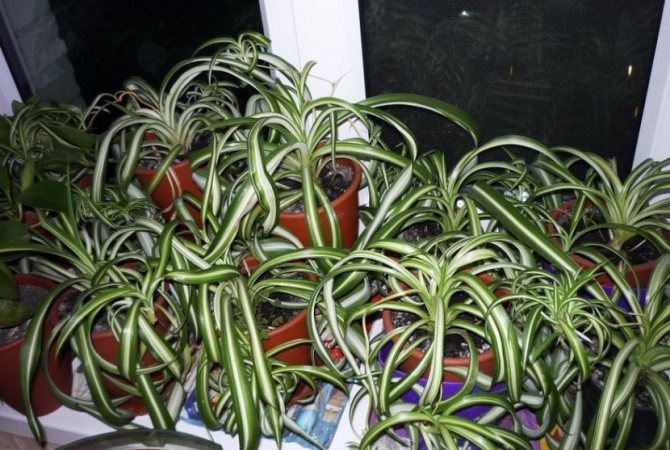

Air humidity
What will be the concentration of moisture in the air in the room for chlorophytum does not matter. It will do great in hot weather without spraying. But it is advisable to remove dust from its leaves. This can be done using an ordinary warm shower. It is advisable to perform the procedure in the morning.
Important! It is necessary to wash off the dust very carefully, as long thin leaves break easily. If this happens, it is better to remove the leaf completely so that there is no bacterial contamination. New leaves will appear quickly.

